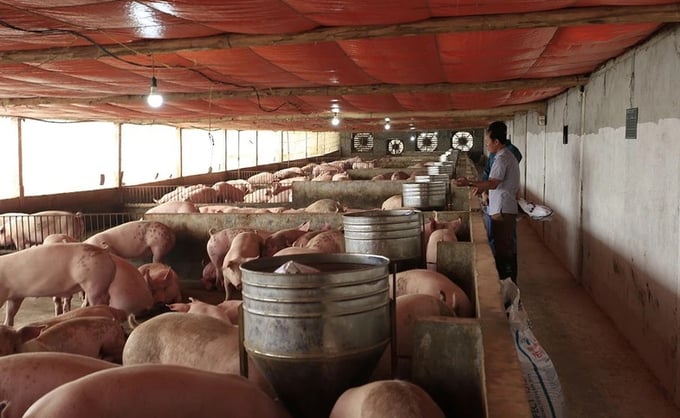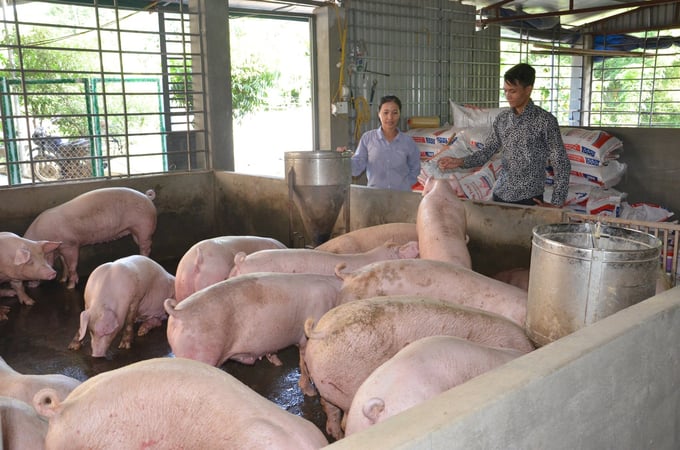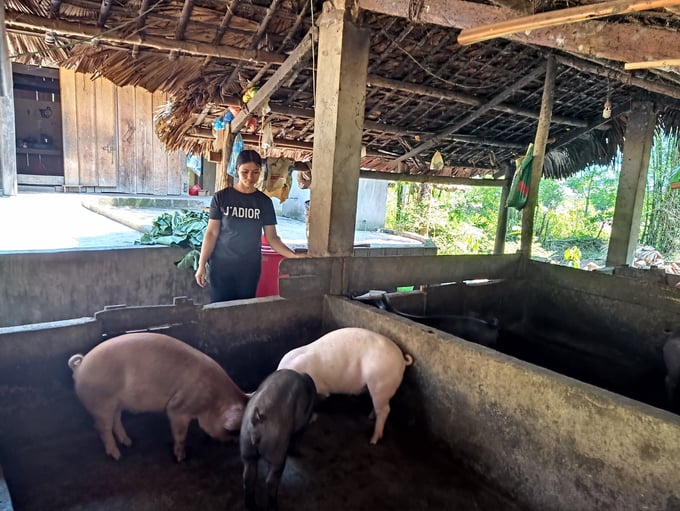June 21, 2025 | 02:47 GMT +7
June 21, 2025 | 02:47 GMT +7
Hotline: 0913.378.918
June 21, 2025 | 02:47 GMT +7
Hotline: 0913.378.918

The majority of large-scale livestock farms maintain an environment conducive to disease prevention. Photo: HD.
Bao Thang District is a key livestock production area in Lao Cai province, with a policy that encourages the transition from small-scale to concentrated, biosafe farming practices in association with environmental protection.
Mr. Nguyen Van Huong, a farmer residing in Xuan Ly hamlet, Gia Phu commune, Bao Thang district, Lao Cai province, is currently managing a herd of 1,000 pigs. As one of the largest pig farming households in Gia Phu commune, the family's capital investment and main income are directly tied to pig farming activities. Mr. Huong's primary concerns in livestock farming include breeding stock sourcing, care, disease prevention, and waste management.
"Effective waste management in livestock farming is crucial; otherwise, it can impact the health of the animals, pose risks of disease transmission, and contribute to environmental pollution. I have installed a biogas system to utilize a portion of the waste as fuel.
Furthermore, waste and wastewater from the livestock pens are collected and treated with biological agents. As a result, livestock waste is utilized as an organic fertilizer for crops," Mr. Nguyen Van Huong detailed.
Similarly, Ms. Nguyen Thi Nga, owner of a livestock farm in Lang Bong village, Xuan Quang commune, Bao Thang district, Lao Cai province, implements biosafety measures on her farm to actively prevent diseases among the livestock. Consequently, the market price for her pigs is consistently higher than the general market price.
"Biosafety is crucial priority in pig farming, especially considering the livestock's current high susceptibility to disease outbreaks. All of the imported feed and farming tools on our farm must undergo disinfection before being introduced to the pens. Vehicles and workers must be disinfected and quarantined before gaining access the livestock area," Ms. Nguyen Thi Nga shared.
Large-scale livestock farms in Bao Thang district has effectively employed biosafety measures, and actively prevented diseases among their livestock and poultry. However, fragmented and smallholder livestock farming operations remain prevalent.

Communities in the highland regions are increasingly prioritizing the care and disease prevention aspects of livestock management. Photo: HD.
According to Mr. Vu Kieu Hung, Deputy Head of Bao Thang district's Department of Agriculture and Rural Development, farmers in the district possess considerable knowledge and experience in livestock farming. Additionally, the community's proficiency in utilizing scientific and technological advancements and employing disease prevention measures has contributed to the stable development of the local livestock herd over the years. However, vaccination against livestock diseases remains a significant point of concern.
"Preventive measures against livestock diseases are a priority in Bao Thang district. The local government and specialized agencies have actively promoted the adoption of appropriate livestock farming practices to prevent disease outbreaks. These activities include implementing regular and comprehensive vaccination schedules for each type of livestock; enhancing sanitation, detoxification, and disinfection efforts in livestock pens and facilities; maintaining daily livestock health monitoring to implement effective intervention measures when necessary," Mr. Vu Kieu Hung explained.
Notably, livestock pens must be established in well-ventilated and secure areas, with raised floors and separate enclosures for livestock and poultry. A drainage system must be installed within the farming area. Waste storage areas must be positioned downwind, at low elevation, and away from the pens and and groundwater sources. Disinfection pits must be placed at the entrance of the livestock pens to prevent disease transmission.
Furthermore, effective livestock and poultry management contributes to enhancing their disease resistance. Livestock feed must be provided in adequate quantities and nutritional content, free from moisture and mold. Supplementary feed should include various vitamins and minerals to enhance the animals' immune systems. Additionally, a clean water source is essential to the well-being of a livestock or poultry herd.
Regular cleaning and maintenance of livestock pens, feeding troughs, waterers, and other farming equipment are essential. Moreover, periodic disinfection and sanitization of the livestock pens are necessary to eradicate disease-causing pathogens.
Furthermore, vaccination against dangerous infectious diseases in livestock must be administered in compliance with the correct schedule and procedures. Some notable diseases include: foot-and-mouth disease, blue-ear pig disease, swine fever, pasteurellosis, paratyphoid, and lumpy skin disease.
Regular livestock health examinations allow farmers to promptly detect diseases, thereby enabling timely quaratine and treatment to prevent further spread of the disease within the herd.

Small-scale livestock farmers are fully aware of the importance of maintaining livestock pen hygiene in protecting the health of their animals. Photo: HD.
Livestock farming inherently poses the threat of disease outbreaks, which can significantly affect the environment and community well-being. Consequently, Lao Cai province's livestock sector has actively promoted the adoption of diverse and innovative waste management models. These initiatives aim to protect environmental hygiene, mitigate risks, and boost economic efficiency.
The issue of waste management in livestock farming at large-scale facilities has received significant investment to comply with farm economics regulations. However, there is a greater risk of environmental pollution at small-scale livestock farms.
The majority of local small-scale livestock farms are interspersed within residential areas, utilizing available land for the construction of farming facilities. Due to limited investment capital, these operations often neglect the establishment of environmental protection infrastructure and waste management systems.
Lao Cai province is currently managing over 77,000 livestock farming households. Among this group, 61,000 households own hygienic and enclosed pens, accounting for 79.4% of the province's total livestock households. However, over 15,000 households fail to meet environmental sanitation standards, accounting for 20.6% of the province's total livestock households.
The majority of households with inadequate environmental sanitation are small-scale and scattered throughout the rural and highland areas, with unchanged perceptions and production habits.
In response to these challenges, the province has implemented various waste collection and processing models in livestock farming over the years to utilize waste as organic fertilizer, and generate biogas for daily use. This waste collection and processing initiative has transformed livestock waste into a valuable resource, while simultaneously reducing environmental pollution.
In addition to traditional composting methods, multiple local households have adopted advanced technologies to maintain environmental sanitation. There are 11,000 livestock households currently implementing waste treatment through bio-digesters and bio-bedding systems throughout the province. Notably, there are approximately 7,000 households utilizing bio-digesters and 4,000 households utilizing bio-bedding systems.
Ms. Pham Thi Hoa, Deputy Director of Lao Cai province's Sub-Department of Livestock Production and Animal Health, reported that the local livestock sector has placed significant emphasis on waste management and environmental protection efforts over the years. These tasks have been achieved through the adoption of various innovative models, such as bio-digester and bio-bedding projects, which have seen widespread implementation and adoption by numerous livestock households. Ms. Hoa highlighted the critical need for a shift in awareness and practices to maintain environmental sustainability in livestock farming.
"Small-scale livestock farmers often overlook environmental concerns due to limited investments. As a result, we have been actively urging and instructing local governments to strengthen management and environmental protection duties in accordance with the Law on Livestock Production. On the other hand, the local livestock sector has promoted awareness campaigns and encouraged local communities to engage in environmental protection practices; provided technical support to livestock farmers that are implementing advanced waste management techniques aimed at maintaining environmental hygiene." added Ms. Hoa.
Reportedly, Lao Cai province currently houses a total livestock herd of nearly 612,000 animals, and a total poultry herd of nearly 5 million. Local livestock production has supplied the market with over 16,000 tons of assorted meat since the beginning of 2024, meeting the consumption demands of the local population.
Translated by Nguyen Hai Long
![Turning wind and rain into action: [9] Digitizing hydrometeorological data in response to climate change](https://t.ex-cdn.com/nongnghiepmoitruong.vn/608w/files/news/2025/06/17/z6704423696987_15fd32ffc26d590d204d520c9dac6786-nongnghiep-165943.jpg)
(VAN) Farmers have begun accessing hydrometeorological applications to adjust their cropping schedules, aiming to ensure productivity and adapt to climate change.
![Turning wind and rain into action: [8] Real-time salinity detection and early warning technology](https://t.ex-cdn.com/nongnghiepmoitruong.vn/608w/files/news/2025/06/17/z6704423696987_15fd32ffc26d590d204d520c9dac6786-nongnghiep-151127.jpg)
(VAN) Thanks to the integration of modern hydrological-hydraulic models, remote sensing technologies, and artificial intelligence, the accuracy of hydrological forecasting has significantly improved.
![Turning wind and rain into action: [7] Early disaster warnings help marine farmers minimize losses](https://t.ex-cdn.com/nongnghiepmoitruong.vn/608w/files/news/2025/06/17/z6704423696987_15fd32ffc26d590d204d520c9dac6786-nongnghiep-142942.jpg)
(VAN) In recent years, thanks to early disaster warnings and forecasting, marine farmers in Khanh Hoa province have been able to reduce risks and losses, thereby improving production efficiency.
![Turning wind and rain into action: [6] ‘Four on-the-spot’ disaster management software](https://t.ex-cdn.com/nongnghiepmoitruong.vn/608w/files/news/2025/06/17/e5a48259d6a262fc3bb3-nongnghiep-183800.jpg)
(VAN) By simply activating the scenario on the disaster management software, the relevant authorities immediately know how many households need to be evacuated, where to evacuate them to, and by what means of transportation…
![Turning wind and rain into action: [5] Hue applies modern technology in disaster forecasting](https://t.ex-cdn.com/nongnghiepmoitruong.vn/608w/files/news/2025/06/17/z6704423696987_15fd32ffc26d590d204d520c9dac6786-nongnghiep-093938.jpg)
(VAN) In Hue city, modern technology has recently been applied in meteorological and hydrological forecasting and warning, helping to reduce the damage caused by natural disasters.

(VAN) A cutting-edge farming technique being implemented on an experimental ranch in Arizona's Sonoran Desert has already saved a billion gallons of water over five years, according to Civil Eats.

(VAN) Poultry and pig production and the environment can be boosted through enhanced water technology, according to new research.